
Which L sugar on oxidation gives an optically active dibasic acid ( 2 - COOH groups)?
A)
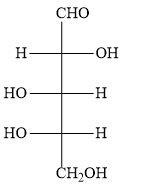
B)
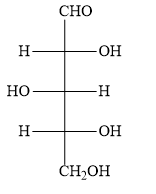
C)

D)
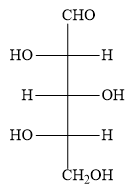




Answer
497.7k+ views
2 likes
Hint: In the Fischer projection formula for D-sugar, the bottom most asymmetric carbon atom has hydroxyl group on the right. In the Fischer projection formula for L-sugar, the bottom most asymmetric carbon atom has hydroxyl group on the left. When a sugar molecule is oxidised, the product is a dibasic acid. If a plane of symmetry is present, the product is optically inactive.
Complete step by step answer:
The options B ) and C ) represent D- sugars as in the fischer projection formula, the bottom most asymmetric carbon atom has hydroxyl group on the right. But in the question, you have to find optically active dibasic acid from L-sugar. Hence, the options B ) and C ) are ruled out.
The options A ) and D ) represent L- sugars as in the fischer projection formula, the bottom most asymmetric carbon atom has hydroxyl group on the left.
When a sugar molecule is oxidised, the aldehyde group is converted to a carboxylic group. Similarly, the primary alcohol group is also oxidised to the carboxylic group. Thus, the oxidation of sugar gives a dicarboxylic acid. The product is dibasic acid with two carboxylic acid groups.
When the sugar in option D ) is oxidized, the product dicarboxylic acid contains a plane of symmetry (a mirror plane). Hence, the product is optically inactive. But in the question, you have to find optically active dibasic acid from L-sugar. Hence, the option D ) is ruled out.
When the sugar in option A ) is oxidized, the product dicarboxylic acid does not contain a plane of symmetry (a mirror plane). Hence, the product is optically active. In the question also, you have to find optically active dibasic acid from L-sugar.
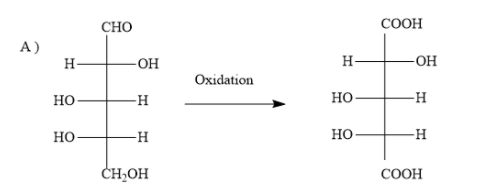
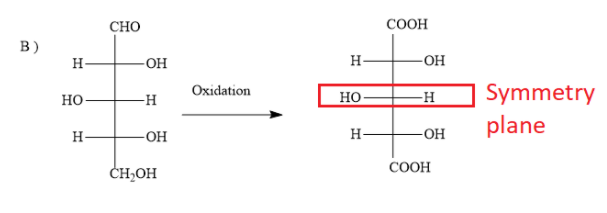
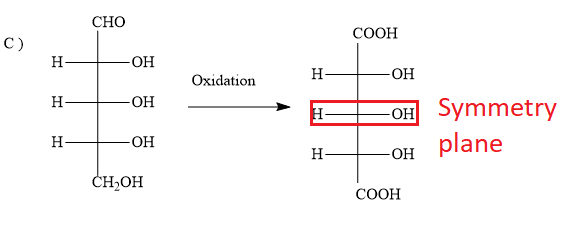
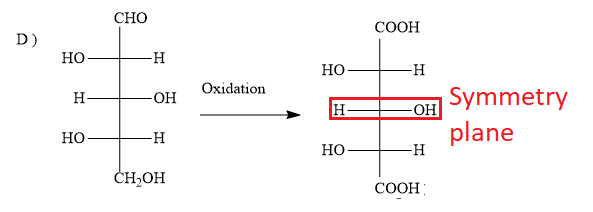
Hence, the option A ) is the correct option.
Note: When a symmetry plane is present, the product will be optically inactive due to internal compensation. Such products are meso forms. When a symmetry plane is absent, the product is optically active and present as enantiomeric pairs.
Complete step by step answer:
The options B ) and C ) represent D- sugars as in the fischer projection formula, the bottom most asymmetric carbon atom has hydroxyl group on the right. But in the question, you have to find optically active dibasic acid from L-sugar. Hence, the options B ) and C ) are ruled out.
The options A ) and D ) represent L- sugars as in the fischer projection formula, the bottom most asymmetric carbon atom has hydroxyl group on the left.
When a sugar molecule is oxidised, the aldehyde group is converted to a carboxylic group. Similarly, the primary alcohol group is also oxidised to the carboxylic group. Thus, the oxidation of sugar gives a dicarboxylic acid. The product is dibasic acid with two carboxylic acid groups.
When the sugar in option D ) is oxidized, the product dicarboxylic acid contains a plane of symmetry (a mirror plane). Hence, the product is optically inactive. But in the question, you have to find optically active dibasic acid from L-sugar. Hence, the option D ) is ruled out.
When the sugar in option A ) is oxidized, the product dicarboxylic acid does not contain a plane of symmetry (a mirror plane). Hence, the product is optically active. In the question also, you have to find optically active dibasic acid from L-sugar.




Hence, the option A ) is the correct option.
Note: When a symmetry plane is present, the product will be optically inactive due to internal compensation. Such products are meso forms. When a symmetry plane is absent, the product is optically active and present as enantiomeric pairs.
Latest Vedantu courses for you
Grade 10 | CBSE | SCHOOL | English
Vedantu 10 CBSE Pro Course - (2025-26)
School Full course for CBSE students
₹34,850 per year
Recently Updated Pages
Master Class 12 Business Studies: Engaging Questions & Answers for Success

Master Class 12 English: Engaging Questions & Answers for Success

Master Class 12 Social Science: Engaging Questions & Answers for Success

Master Class 12 Chemistry: Engaging Questions & Answers for Success

Class 12 Question and Answer - Your Ultimate Solutions Guide

Master Class 11 Business Studies: Engaging Questions & Answers for Success

Trending doubts
Draw a labelled sketch of the human eye class 12 physics CBSE

a Tabulate the differences in the characteristics of class 12 chemistry CBSE

Which one of the following is a true fish A Jellyfish class 12 biology CBSE

Why is the cell called the structural and functional class 12 biology CBSE

Differentiate between homogeneous and heterogeneous class 12 chemistry CBSE

Write the difference between solid liquid and gas class 12 chemistry CBSE




